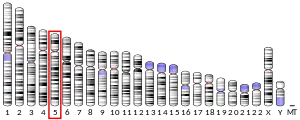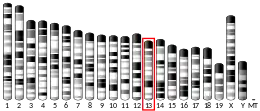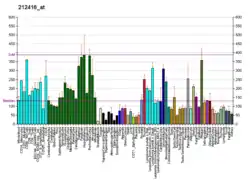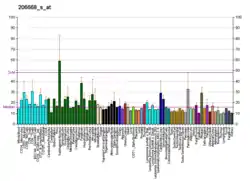SCAMP1
Secretory carrier-associated membrane protein 1 is a protein that in humans is encoded by the SCAMP1 gene.[5][6]
| SCAMP1 | |||||||||||||||||||||||||||||||||||||||||||||||||||
|---|---|---|---|---|---|---|---|---|---|---|---|---|---|---|---|---|---|---|---|---|---|---|---|---|---|---|---|---|---|---|---|---|---|---|---|---|---|---|---|---|---|---|---|---|---|---|---|---|---|---|---|
| Identifiers | |||||||||||||||||||||||||||||||||||||||||||||||||||
| Aliases | SCAMP1, SCAMP, SCAMP37, secretory carrier membrane protein 1 | ||||||||||||||||||||||||||||||||||||||||||||||||||
| External IDs | OMIM: 606911 MGI: 1349480 HomoloGene: 37975 GeneCards: SCAMP1 | ||||||||||||||||||||||||||||||||||||||||||||||||||
| |||||||||||||||||||||||||||||||||||||||||||||||||||
| |||||||||||||||||||||||||||||||||||||||||||||||||||
| |||||||||||||||||||||||||||||||||||||||||||||||||||
| |||||||||||||||||||||||||||||||||||||||||||||||||||
| |||||||||||||||||||||||||||||||||||||||||||||||||||
| Wikidata | |||||||||||||||||||||||||||||||||||||||||||||||||||
| |||||||||||||||||||||||||||||||||||||||||||||||||||
Function
This gene product belongs to the SCAMP family of proteins which are secretory carrier membrane proteins. They function as carriers to the cell surface in post-golgi recycling pathways. Different family members are highly related products of distinct genes, and are usually expressed together. These findings suggest that the SCAMPs may function at the same site during vesicular transport rather than in separate pathways.[6]
References
- GRCh38: Ensembl release 89: ENSG00000085365 - Ensembl, May 2017
- GRCm38: Ensembl release 89: ENSMUSG00000021687 - Ensembl, May 2017
- "Human PubMed Reference:". National Center for Biotechnology Information, U.S. National Library of Medicine.
- "Mouse PubMed Reference:". National Center for Biotechnology Information, U.S. National Library of Medicine.
- Singleton DR, Wu TT, Castle JD (September 1997). "Three mammalian SCAMPs (secretory carrier membrane proteins) are highly related products of distinct genes having similar subcellular distributions". Journal of Cell Science. 110. 110 ( Pt 17) (17): 2099–107. doi:10.1242/jcs.110.17.2099. PMID 9378760.
- "Entrez Gene: SCAMP1 secretory carrier membrane protein 1".
- Fernández-Chacón R, Achiriloaie M, Janz R, Albanesi JP, Südhof TC (April 2000). "SCAMP1 function in endocytosis". The Journal of Biological Chemistry. 275 (17): 12752–6. doi:10.1074/jbc.275.17.12752. PMID 10777571.
Further reading
- Maruyama K, Sugano S (January 1994). "Oligo-capping: a simple method to replace the cap structure of eukaryotic mRNAs with oligoribonucleotides". Gene. 138 (1–2): 171–4. doi:10.1016/0378-1119(94)90802-8. PMID 8125298.
- Brand SH, Castle JD (October 1993). "SCAMP 37, a new marker within the general cell surface recycling system". The EMBO Journal. 12 (10): 3753–61. doi:10.1002/j.1460-2075.1993.tb06053.x. PMC 413657. PMID 8404846.
- Andersson B, Wentland MA, Ricafrente JY, Liu W, Gibbs RA (April 1996). "A "double adaptor" method for improved shotgun library construction". Analytical Biochemistry. 236 (1): 107–13. doi:10.1006/abio.1996.0138. PMID 8619474.
- Yu W, Andersson B, Worley KC, Muzny DM, Ding Y, Liu W, Ricafrente JY, Wentland MA, Lennon G, Gibbs RA (April 1997). "Large-scale concatenation cDNA sequencing". Genome Research. 7 (4): 353–8. doi:10.1101/gr.7.4.353. PMC 139146. PMID 9110174.
- Wu TT, Castle JD (July 1997). "Evidence for colocalization and interaction between 37 and 39 kDa isoforms of secretory carrier membrane proteins (SCAMPs)". Journal of Cell Science. 110. 110 ( Pt 13) (13): 1533–41. doi:10.1242/jcs.110.13.1533. PMID 9224770.
- Suzuki Y, Yoshitomo-Nakagawa K, Maruyama K, Suyama A, Sugano S (October 1997). "Construction and characterization of a full length-enriched and a 5'-end-enriched cDNA library". Gene. 200 (1–2): 149–56. doi:10.1016/S0378-1119(97)00411-3. PMID 9373149.
- Mao M, Fu G, Wu JS, Zhang QH, Zhou J, Kan LX, Huang QH, He KL, Gu BW, Han ZG, Shen Y, Gu J, Yu YP, Xu SH, Wang YX, Chen SJ, Chen Z (July 1998). "Identification of genes expressed in human CD34(+) hematopoietic stem/progenitor cells by expressed sequence tags and efficient full-length cDNA cloning". Proceedings of the National Academy of Sciences of the United States of America. 95 (14): 8175–80. Bibcode:1998PNAS...95.8175M. doi:10.1073/pnas.95.14.8175. PMC 20949. PMID 9653160.
- Wu TT, Castle JD (July 1998). "Tyrosine phosphorylation of selected secretory carrier membrane proteins, SCAMP1 and SCAMP3, and association with the EGF receptor". Molecular Biology of the Cell. 9 (7): 1661–74. doi:10.1091/mbc.9.7.1661. PMC 25404. PMID 9658162.
- Fernández-Chacón R, Achiriloaie M, Janz R, Albanesi JP, Südhof TC (April 2000). "SCAMP1 function in endocytosis". The Journal of Biological Chemistry. 275 (17): 12752–6. doi:10.1074/jbc.275.17.12752. PMID 10777571.
- Zhang QH, Ye M, Wu XY, Ren SX, Zhao M, Zhao CJ, Fu G, Shen Y, Fan HY, Lu G, Zhong M, Xu XR, Han ZG, Zhang JW, Tao J, Huang QH, Zhou J, Hu GX, Gu J, Chen SJ, Chen Z (October 2000). "Cloning and functional analysis of cDNAs with open reading frames for 300 previously undefined genes expressed in CD34+ hematopoietic stem/progenitor cells". Genome Research. 10 (10): 1546–60. doi:10.1101/gr.140200. PMC 310934. PMID 11042152.
- Bell AW, Ward MA, Blackstock WP, Freeman HN, Choudhary JS, Lewis AP, Chotai D, Fazel A, Gushue JN, Paiement J, Palcy S, Chevet E, Lafrenière-Roula M, Solari R, Thomas DY, Rowley A, Bergeron JJ (February 2001). "Proteomics characterization of abundant Golgi membrane proteins". The Journal of Biological Chemistry. 276 (7): 5152–65. doi:10.1074/jbc.M006143200. PMID 11042173.
- Fernández-Chacón R, Südhof TC (November 2000). "Novel SCAMPs lacking NPF repeats: ubiquitous and synaptic vesicle-specific forms implicate SCAMPs in multiple membrane-trafficking functions". The Journal of Neuroscience. 20 (21): 7941–50. doi:10.1523/JNEUROSCI.20-21-07941.2000. PMC 6772721. PMID 11050114.
- Guo Z, Liu L, Cafiso D, Castle D (September 2002). "Perturbation of a very late step of regulated exocytosis by a secretory carrier membrane protein (SCAMP2)-derived peptide". The Journal of Biological Chemistry. 277 (38): 35357–63. doi:10.1074/jbc.M202259200. PMID 12124380.
- Liu L, Guo Z, Tieu Q, Castle A, Castle D (December 2002). "Role of secretory carrier membrane protein SCAMP2 in granule exocytosis". Molecular Biology of the Cell. 13 (12): 4266–78. doi:10.1091/mbc.E02-03-0136. PMC 138632. PMID 12475951.
- Hillman RT, Green RE, Brenner SE (2005). "An unappreciated role for RNA surveillance". Genome Biology. 5 (2): R8. doi:10.1186/gb-2004-5-2-r8. PMC 395752. PMID 14759258.
- Lin PJ, Williams WP, Luu Y, Molday RS, Orlowski J, Numata M (May 2005). "Secretory carrier membrane proteins interact and regulate trafficking of the organellar (Na+,K+)/H+ exchanger NHE7". Journal of Cell Science. 118 (Pt 9): 1885–97. doi:10.1242/jcs.02315. PMID 15840657.
This article is issued from Wikipedia. The text is licensed under Creative Commons - Attribution - Sharealike. Additional terms may apply for the media files.






